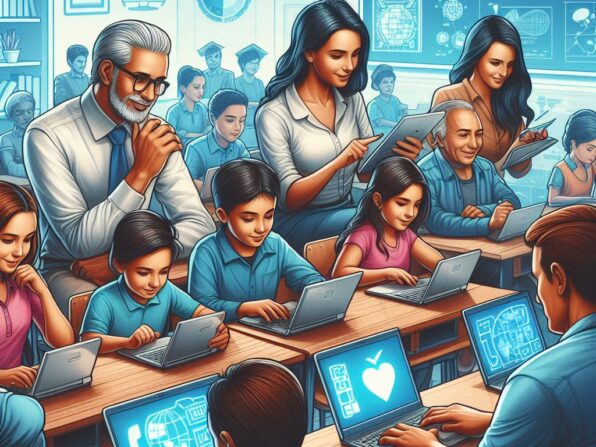Introduction
Nowadays, society is fully technical with a high specialty in the use of mobile devices, applications for communication, entertainment, and acquisition of goods and services, among others. In the case of education, a phenomenon oriented towards the use of technology to achieve autonomy and creative actions in students is observed (Sánchez-López, et al, 2021), for their part, teachers are in a transition in the development of their digital skills, accelerated by the urgency of the health contingency (Bhaumik & Priyadarshini, 2020; Yaşar, & Atay, 2023), demonstrating that they have the necessary technological skills to face changes (Rodrigues et al., 2021; Winter et al., 2021) and a positive attitude to integrate technology into their teaching practice (Suhayat, et al, 2023).

Although the levels of technological competence of teachers are generally heterogeneous, some gaps have been observed, mainly in areas where there is marginalization and few opportunities for professional and economic development (Tugelbayeva et al., 2020), also due to the lack of government support or monitoring programs and continuous training to achieve a better adaptation to the digital environment to enhance teaching (Gupta, et al, 2020).
According to the UNESCO Report on science (Schneegans, et al, 2021), investment in technological infrastructure globally increased from 2014 to 2019 by 19%, mainly in the United States and China. However, in the educational field, despite the implementation of technology and having basic infrastructure, the levels of digital competence have not increased (Cabero-Almenara, et al, 2020; Thorvaldsen & Sollied Madsen, 2021) mainly because trained teachers are required and with continuous professional development in which technologies are fully addressed with digital skills and teaching strategies. Unfortunately, 83% of teachers have the minimum skills and in developing countries, the proportion is one teacher with the minimum qualifications for every 53 students (UNESCO, 2022).
In Mexico, the same problems can be observed: despite having national programmes to support teaching, the development of digital competencies and technological training and empowerment, these have not had the expected impact, mainly because they address two of the six grades of primary education and without evidence at other levels of basic education (Manzanilla-Granados, et al, 2021). In addition, the national digital literacy (DL) programs have had results with little impact on the development of digital skills and abilities because they are not related to the official study programs (Beltrán-Sánchez, et al, 2019; George, 2020; Sámano, et al, 2018).
Therefore, it is necessary to have relevant information on the state of digital competencies of teachers in order to obtain reliable data that will allow better decisionmaking on the present and future of digital skills in a post-confinement environment due to the pandemic and in the face of the challenges posed by the social, economic and public health phenomena of the 21st century (Lucas, et. al, 2021).
Secondary Education and teacher digital competence programs
Secondary education in Mexico is the third stage of the basic education system (SEP, 2017), its curriculum is based on the Key Learning for Comprehensive Education (SEP, 2019) where the importance of teachers in the educational process is described, as well as the actions to achieve their high professionalization and development of competencies such as the transformation of pedagogical practice, initial and continuous teacher training, the improvement of materials, infrastructure, and equipment.
In this context, the training and digital literacy programs for teachers have as reference the @prende 2.0 program (SEP, 2016), whose characteristics are mainly the implementation of technology in the teaching and learning processes, which benefited 16,000 schools. Public schools and the training of eight thousand basic education teachers (Franzoni, et al, 2020). In addition to the fact that this program generated a positive effect on teachers to use technology in their classes (Aponte, et al., 2016).
The context of the Mayan region of Mexico
The state of Yucatán is located on the peninsula of the same name, in the southeast of Mexico. Its population is mainly of Mayan descent whose indigenous language is spoken by 23.70% of the population and of this population, 49.5% is in a situation of poverty (CONEVAL, 2021). Among the main economic activities, we can find tourism, then there is the manufacturing industry and commerce (INEGI, 2023).
The capital of the state is Mérida and it is the economic center of the region, with high levels of reception of the population that is not from the state, as well as being an attractive place for foreigners seeking to retire (Government of Mexico, 2022), due to Yucatan has become an important tourist, rest and investment destination at the national level, however, this progress has not permeated the native population of the Mayan region, deepening the opportunities for a better life for that sector.
In the case of education, according to the INEGI population census (2020), 50% of the Yucatan students aged 15 or over have completed their basic education. It was also found that 86% of the teaching staff is located in urban areas and 14% in rural areas; where there are problems associated with discrimination based on ethnic origin and language (Vargas et al., 2021), which deepens the gaps and opportunities for professional development.
The Problem
After the analysis carried out, it is evident to find problems associated with the gaps that teachers have with the mastery of technologies and their digital competences to use them in their school activities, however, in the literature review it was found that there is a lack of information on the level of digital competency of teachers in the Mayan region in Mexico, particularly in secondary education; it is unknown what is the real state of digital competences that they have mastered. This situation is serious because there is no information that would allow the design of national policies to train teachers and meet their equipment needs in order to meet the challenges of today’s education, where students demand teachers who provide them with quality knowledge, with innovative strategies and high digital and technological content. So what is the level of digital competency of secondary school teachers in the Mayan region of Mexico?
The Objectives
O1. To identify the level of digital competence of secondary school teachers in the Mayan region of Mexico.
O2. To identify if there are differences in the level of digital competence of secondary school teachers in the Mayan region of Mexico with other variables.
See more: https://doi.org/10.29333/iji.2024.17234a

